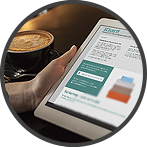Four ways to keep email and chat apart
Datum: 2025-11-10 09:25

Chat-based collaboration platforms like Microsoft Teams, Slack, and others are, in my opinion, welcome additions to the flora of tools we can use these days. Some of us have been using them for years, while for others they are something completely new.
For you who prefer listening to reading, this post is also available as an episode of the ""Done!"" podcast:
Freer and easier
Chat has many merits; I find there is something liberating about being able to be more succinct there than in emails without sounding rude, and many of my clients testify to how nice it is to get the email volume down when some of the correspondence has moved over to chat.
Or, much messier than before?
At the same time, the introduction of Teams and Slack can mess up communication big time, because now there are conversations about all sorts of things in both chat and email, back and forth, back and forth, and there is no order to it at all. We lose “where we are” in the various conversations, we find it hard to find our way back to a thread we had somewhere, and when we talk about an issue in several places we might end up saying the same thing over and over but in different channels.
Make the difference clear
The solution lies in drawing a clear line between email and chat so that it becomes more obvious to those working together what they should use chat for and what emails are for.
If that line is not clear today for you and your colleagues, that is what I would encourage you to address now.
Do this
During the next appropriate meeting with your colleagues, discuss what would be an appropriate boundary between chat and email for you.
What are the possible boundaries to choose from? Well, here are four variations that I have picked up on from clients — and from how I work myself, in addition to that:
- External/Internal — You conduct the external conversations in emails while all internal communication happens in the chat.
- Channel not available/channel available — If there is no chat channel for what is to be discussed (and it is clear that there should not be one), you communicate via email. If there is a chat channel for the matter, the chat should be used — not the email.
- Long/short - You use email for longer, more extensive exchanges of information and chat only for short questions, issues, and so on.
- Non-immediate response/quick response — If the answer is not urgent, you use email, but if the matter is urgent, you use chat.
Agree on a boundary for you to try out — if only among your team. Naturally, you might need and want to try something completely different from the four examples of boundaries listed here.
Decide on a test period — a month, for example — and then evaluate how it has worked for you. Has it become easier to distinguish the tools from each other? Has it been easier to follow the conversations? Is the boundary setting comprehensive enough? Make any necessary adjustments and try again.
Smoother collaboration
If you clarify the boundaries between emails and chat, you will be able to make better use of both tools. You will use them more for what they are made for, the way you use them will be smoother than before, and the use you get from them greater as well. If you collaborate a lot during your workday, this will make a big difference.
How do you do it?
In fact, is the line between chat and email already clear to you and your colleagues? Great! What have you done to draw the line? Please write to me and let me know.
(Do you sometimes feel overwhelmed by unanswered emails, chats and texts? Find out in this short video how quickly you are expected to respond.)
You can get more!

If you want more tips on how to create good structure at work, there are many ways to get that from me - in podcasts, videos, books, talks and other formats.




